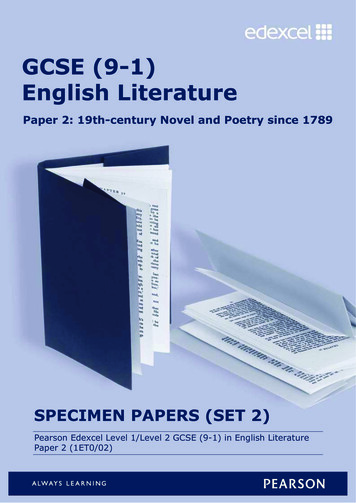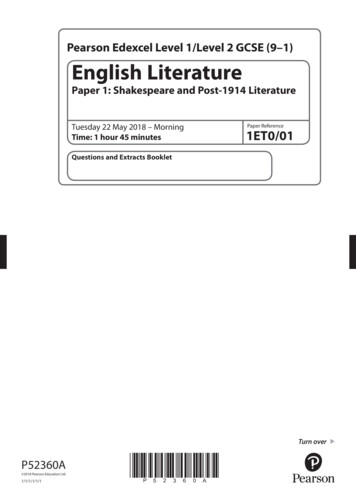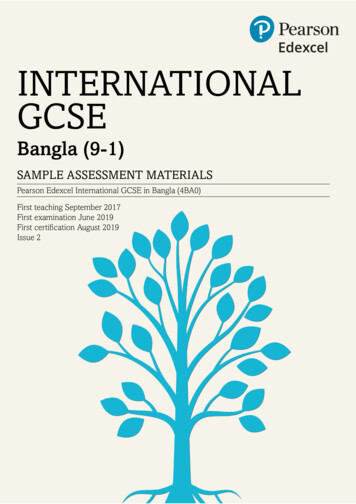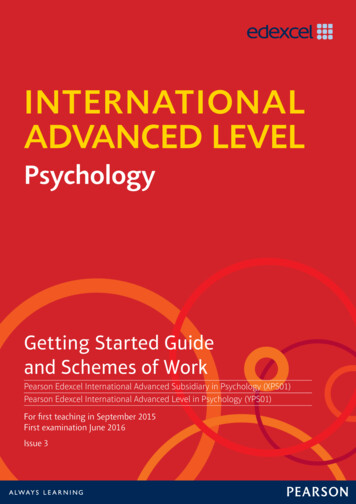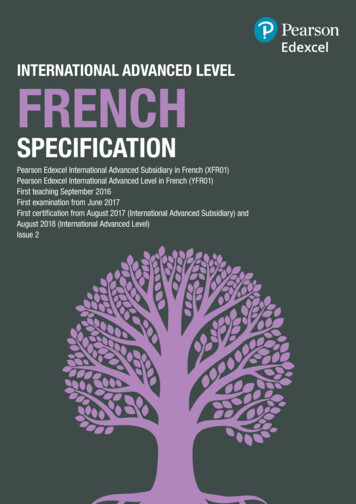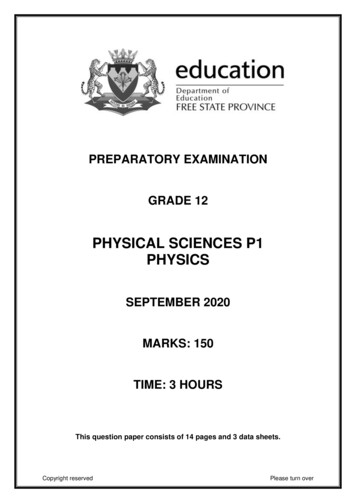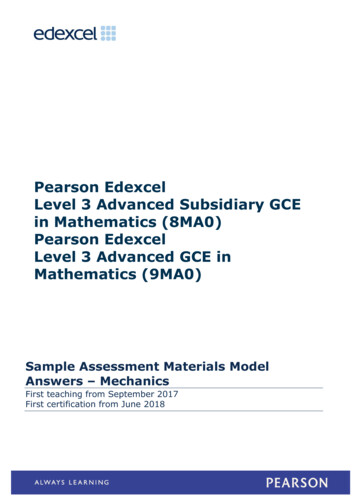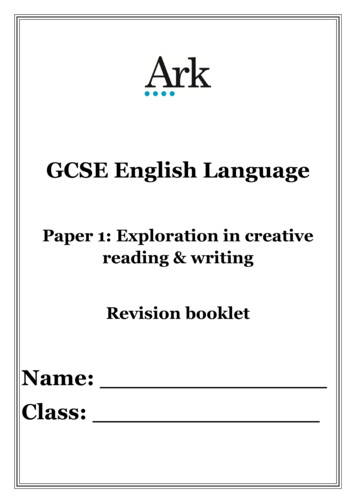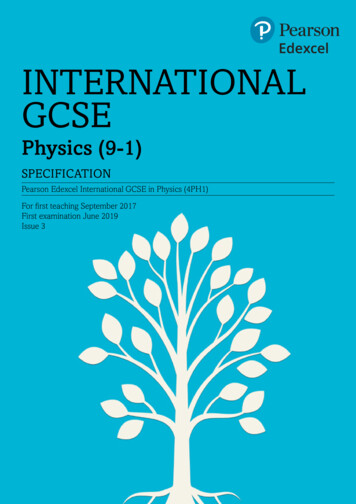
Transcription
INTERNATIONALGCSEPhysics (9-1)SPECIFICATIONPearson Edexcel International GCSE in Physics (4PH1)For first teaching September 2017First examination June 2019Issue 3
Edexcel, BTEC and LCCI qualificationsEdexcel, BTEC and LCCI qualifications are awarded by Pearson, the UK’s largest awardingbody offering academic and vocational qualifications that are globally recognised andbenchmarked. For further information, please visit our qualifications website atqualifications.pearson.com. Alternatively, you can get in touch with us using the details onour contact us page at qualifications.pearson.com/contactusAbout PearsonPearson is the world's leading learning company, with 22,500 employees in more than70 countries working to help people of all ages to make measurable progress in their livesthrough learning. We put the learner at the centre of everything we do, because whereverlearning flourishes, so do people. Find out more about how we can help you and yourlearners at qualifications.pearson.comAcknowledgementsThis specification has been produced by Pearson on the basis of consultation with teachers,examiners, consultants and other interested parties. Pearson would like to thank all thosewho contributed their time and expertise to the specification’s development.References to third party materials made in this specification are made in good faith.Pearson does not endorse, approve or accept responsibility for the content of materials,which may be subject to change, or any opinions expressed therein. (Materials may includetextbooks, journals, magazines and other publications and websites.)All information in this specification is correct at time of publication.ISBN 978 1 446 93119 6All the material in this publication is copyright Pearson Education Limited 2021
Summary of Pearson Edexcel International GCSE inPhysics (4PH1) specification Issue 3 changesSummary of changes made between previous issue and thiscurrent issuePage numberThe following relationship between charge, current, voltage, resistanceand electrical power in Appendix 7: Physics formulae for relationshipshas been amended to include the formula for energy transferred,covered in the specification. It now reads as follows:52(11)the relationship between charge, current, voltage, resistance,energy and power:charge current x timevoltage current x resistanceelectrical power voltage x currentenergy transferred charge x voltageEarlier issue shows previous changes.If you need further information on these changes or what they mean, contact us viaour website at: tml.
Contents1About this specification1Why choose Pearson Edexcel qualifications?4Why choose the Pearson Edexcel International GCSE in Physics? 52Qualification at a glance3Physics content10Assessment information294512345678Forces and motionElectricityWavesEnergy resources and energy transfersSolids, liquids and gasesMagnetism and electromagnetismRadioactivity and particlesAstrophysics81114161921232527Assessment requirements29Assessment objectives and weightings31Relationship of assessment objectives and papers31Administration and general information33Entries and forbidden combinations33Access arrangements, reasonable adjustments, specialconsideration and malpractice33Malpractice35Awarding and reporting35Student recruitment and progression35AppendicesAppendix 1: Codes3739Appendix 2: Pearson World Class Qualification design principles 41Appendix 3: Transferable skills43Appendix 4: Mathematical skills45Appendix 5: Command word taxonomy47Appendix 6: Suggested practical investigations49Appendix 7: Physics formulae for relationships51Appendix 8: Electrical circuit symbols53Appendix 9: Glossary55
1 About this specificationThe Pearson Edexcel International GCSE in Physics is part of a suite of International GCSEqualifications offered by Pearson.This qualification is not accredited or regulated by any UK regulatory body.This specification includes the following key features.Structure:The Pearson Edexcel International GCSE in Physics is a linear qualification.Two written examinations must be taken in the same series at the end of the course of study.Content:Relevant, engaging, up-to-date and of equivalent standard to Pearson’s regulated GCSE inPhysics.Assessment:Untiered, written examinations with questions designed to be accessible to students of allabilities.Approach:It builds a foundation for students wishing to progress to the Pearson Edexcel AdvancedSubsidiary and Advanced GCE, International AS and A Level qualifications or equivalentqualifications, focusing on key physics theory.Specification updatesThis specification is Issue 3 and is valid for first teaching from September 2017, with firstassessment from June 2019 and first certification from August 2019. If there are anysignificant changes to the specification, Pearson will inform centres in writing. Changes willalso be posted on our website.For more information, please visit qualifications.pearson.comUsing this specificationThis specification gives teachers guidance and encourages delivery of the qualification. Thefollowing information will help you get the most out of the content and guidance.Content:This is arranged as eight topics in Section 3: Physics content. A summary ofsub-topics is included at the start of each topic. As a minimum, all the bullet points in the contentmust be taught. The word ‘including’ in the content specifies the detail of what must be covered.Examples:Throughout the content, we have included examples of what could be covered or what mightsupport teaching and learning. It is important to note that examples are for illustrativepurposes only and centres can use other examples. We have included examples that areeasily understood and recognised by international centres.Practical investigations:These are included within Section 3: Physics content as specification points in italics. Studentswill develop knowledge and understanding of experimental skills through the context of thephysics they are learning. Experimental skills are assessed through written examinations.Referencing:Specification statements that are in bold with a ‘P’ reference relate to content that is in theInternational GCSE in Physics only and is not found in the International GCSE in Science(Double Award).Pearson Edexcel International GCSE in PhysicsSpecification – Issue 3 – December 2021 Pearson Education Limited 20211
Course introductionThe Pearson Edexcel International GCSE in Physics is designed for use in schools andcolleges. It is part of a suite of International GCSE qualifications offered by Pearson.The course gives students the opportunity to experience physics within the context of theirgeneral education.How assessment relates to the qualifications available is shown below.Biology Paper 1Untiered Biology Paper 2UntieredInternationalGCSE in Biology Chemistry Paper 2UntieredInternationalGCSE inChemistry Physics Paper 2UntieredInternationalGCSE in Physics Chemistry Paper 1Untiered Physics Paper 1UntieredInternationalGCSE in Science(Double Award)A Pearson Edexcel International GCSE in Science (Single Award) qualification is alsoavailable. This will cover approximately 50 per cent of the Pearson Edexcel InternationalGCSE in Science (Double Award) specification, while still having a comparable level of rigourand demand.2Pearson Edexcel International GCSE in PhysicsSpecification – Issue 3 – December 2021 Pearson Education Limited 2021
Qualification aims and objectivesThe aims and objectives of this qualification are to enable students to: learn about unifying patterns and themes in physics and use them in new and changingsituations acquire knowledge and understanding of physical facts, terminology, concepts, principlesand practical techniques apply the principles and concepts of physics, including those related to the applications ofphysics, to different contexts evaluate physical information, making judgements on the basis of this information appreciate the practical nature of physics, developing experimental and investigative skillsbased on correct and safe laboratory techniques analyse, interpret and evaluate data and experimental methods, drawing conclusions thatare consistent with evidence from experimental activities and suggesting possibleimprovements and further investigations recognise the importance of accurate experimental work and reporting scientific methodsin physics select, organise and present relevant information clearly and logically using appropriatevocabulary, definitions and conventions develop a logical approach to problem solving in a wider context select and apply appropriate areas of mathematics relevant to physics as set out undereach topic prepare for more advanced courses in physics and for other courses that requireknowledge of physics.Pearson Edexcel International GCSE in PhysicsSpecification – Issue 3 – December 2021 Pearson Education Limited 20213
Why choose Pearson Edexcel qualifications?Pearson – the world’s largest education companyEdexcel academic qualifications are from Pearson, the UK’s largest awarding organisation.With over 3.4 million students studying our academic and vocational qualificationsworldwide, we offer internationally recognised qualifications to schools, colleges andemployers globally.Pearson is recognised as the world’s largest education company, allowing us to driveinnovation and provide comprehensive support for Pearson Edexcel students in acquiring theknowledge and skills they need for progression in study, work and life.A heritage you can trustThe background to Pearson becoming the UK’s largest awarding organisation began in 1836,when a royal charter gave the University of London its first powers to conduct exams andconfer degrees on its students. With over 150 years of international education experience,Edexcel qualifications have firm academic foundations, built on the traditions and rigourassociated with Britain’s educational system.Results you can trustPearson’s leading online marking technology has been shown to produce exceptionallyreliable results, demonstrating that, at every stage, Pearson Edexcel qualifications maintainthe highest standards.Developed to Pearson’s world class qualifications standardsPearson’s world class standards mean that all Pearson Edexcel qualifications are developedto be rigorous, demanding, inclusive and empowering. We work collaboratively with a panelof educational thought leaders and assessment experts to ensure that Pearson Edexcelqualifications are globally relevant, represent world-class best practice and maintain aconsistent standard.For more information on the World Class Qualification process and principles, please go toAppendix 2: Pearson World Class Qualification design principles or visit our tml4Pearson Edexcel International GCSE in PhysicsSpecification – Issue 3 – December 2021 Pearson Education Limited 2021
Why choose the Pearson Edexcel InternationalGCSE in Physics?We have listened to feedback from all parts of the international school, UK independentschool and language teaching community including a large number of teachers. We havemade changes that will engage students and give them skills that will support progression tofurther study in physics, physical science and other related subjects. Our content andassessment approach has been designed to meet students’ needs and be consistent with ourapproach across the sciences.Key qualification featuresAt Pearson, we offer separate science qualifications in Biology, Human Biology, Chemistry andPhysics, as well as Double Award and Single Award Science qualifications – these have beendesigned to meet different students’ needs. The content and assessment approach in all ourscience qualifications has been designed to meet students’ needs in the following ways. Content that is interesting and engaging for students but is also designed to ensure goodpreparation, both for those continuing to further study and for those wishing to work in aphysics-related field. There are opportunities to ‘localise’ the content to make it more relevant for students intheir own country.Clear and straightforward question papers Our question papers are clear and accessible for students of all abilities. Our markschemes are straightforward, so that the assessment requirements are clear.Broad and deep development of students' skills The design of the revised international GCSE aims to extend students' knowledge andunderstanding by broadening and deepening skills, for example students develop theability to:–focus on practical skills through a number of practicals listed in the specificationcontent. These can be supplemented with other suggested practicals.The skills developed will be assessed through questions in written examinations–improve students’ analytical and logic skills by applying understanding of scientificconcepts and principles to a range of situations. This will include some examinationquestions that are more problem-solving in style–address the need for mathematical skills to complement students’ physics skillsby covering a range of mathematical areas.ProgressionInternational GCSE qualifications enable successful progression to A Level and beyond.Through our World Class Qualification development process, we have consulted withInternational Advanced Level and GCE A Level teachers as well as higher educationprofessionals to validate the appropriateness of the qualification, including its content, skillsdevelopment and assessment structure.Courses to suit your students’ needs and interestsTeachers of physics have a choice of International GCSE courses to deliver, each givingdifferent levels of depth to meet students’ needs. As well as the Pearson EdexcelInternational GCSE in Physics, students can also be taught our International GCSE in Science(Double Award) or our International GCSE in Science (Single Award). These courses offer aPearson Edexcel International GCSE in PhysicsSpecification – Issue 3 – December 2021 Pearson Education Limited 20215
reduced amount of content, but are assessed to the same standard. Progression routes forthese courses may vary slightly from those for the Pearson Edexcel International GCSE inPhysics.More information about all our qualifications can be found on our website(qualifications.pearson.com) on the Pearson Edexcel International GCSE pages.6Pearson Edexcel International GCSE in PhysicsSpecification – Issue 3 – December 2021 Pearson Education Limited 2021
Supporting you in planning and implementingthis qualificationPlanning Our Getting Started Guide gives you an overview of the Pearson Edexcel InternationalGCSE in Physics to help you understand the changes to content and assessment, andwhat these changes mean for you and your students. We will provide you with course planner and an editable scheme of work. Our mapping documents highlight key differences between the new and legacyqualifications.Teaching and learning Print and digital learning and teaching resources promote any time, any place learning toimprove student motivation and encourage new ways of working.Preparing for examsWe will also provide you with a range of resources to help you prepare your students for theassessments, including: specimen papers to support formative assessments and mock exams examiner commentaries following each examination series.ResultsPlusResultsPlus provides the most detailed analysis available of your students’ examperformance. It can help you to identify the topics and skills where further learning wouldbenefit your students.examWizardThis is a free online resource designed to support students and teachers with examinationpreparation and assessment.Training eventsIn addition to online training for teachers to deepen their understanding of our qualifications,we host a series of training events each year.Get help and supportOur subject advisor service will ensure that you receive help and guidance from us. You canemail our subject advisor at: teachingscience@pearson.com. You can also sign up to receiveupdates to keep up to date with our qualifications and allied support and service news.Pearson Edexcel International GCSE in PhysicsSpecification – Issue 3 – December 2021 Pearson Education Limited 20217
2 Qualification at a glanceQualification overviewThe Pearson Edexcel International GCSE in Physics consists of two externally-assessedpapers: Physics Paper 1 Physics Paper 2.Content and assessment overviewPhysics Paper 1Paper codes 4PH1/1Pand 4SD0/1P*Externally assessed61.1% of the totalInternational GCSEWritten examination: 2 hoursAvailability: January and JuneFirst assessment: June 2019110 marksContent summaryAssesses core content that is not in bold and does not have a ‘P’ reference. Questions maycome from any topic area across the specification.1Forces and motion2Electricity3Waves4Energy resources and energy transfers5Solids, liquids and gases6Magnetism and electromagnetism7Radioactivity and particles8AstrophysicsAssessmentA combination of different question styles, including multiple-choice questions, shortanswer questions, calculations and extended open-response questions.A calculator may be used in the examinations.8Pearson Edexcel International GCSE in PhysicsSpecification – Issue 3 – December 2021 Pearson Education Limited 2021
Physics Paper 2Paper code 4PH1/2P*Externally assessed38.9% of the totalInternational GCSEWritten examination: 1 hour and 15 minutesAvailability: January and JuneFirst assessment: June 201970 marksContent summaryAssesses all the content, including content that is in bold and has a ‘P’ reference.Questions may come from any topic area across the specification.Statements in bold cover some sub-topics in greater depth.1Forces and motion2Electricity3Waves4Energy resources and energy transfers5Solids, liquids and gases6Magnetism and electromagnetism7Radioactivity and particles8AstrophysicsAssessmentA combination of different question styles, including multiple-choice questions, shortanswer questions, calculations and extended open-response questions.A calculator may be used in the examinations.* See Appendix 1: Codes for a description of this code and all the other codes relevant tothis qualification.Pearson Edexcel International GCSE in PhysicsSpecification – Issue 3 – December 2021 Pearson Education Limited 20219
3 Physics content101Forces and motion112Electricity143Waves164Energy resources and energy transfers195Solids, liquids and gases216Magnetism and electromagnetism237Radioactivity and particles258Astrophysics27Pearson Edexcel International GCSE in PhysicsSpecification – Issue 3 – December 2021 Pearson Education Limited 2021
1 Forces and motionThe following sub-topics are covered in this section.(a)Units(b)Movement and position(c)Forces, movement, shape and momentum(a)UnitsStudents should:1.1use the following units: kilogram (kg), metre (m), metre/second (m/s),metre/second2 (m/s2), newton (N), second (s) and newton/kilogram (N/kg)1.2Puse the following units: newton metre (Nm), kilogram metre/second(kg m/s)(b)Movement and positionStudents should:1.3plot and explain distance time graphs1.4know and use the relationship between average speed, distance moved and timetaken:average speed distance movedtime taken1.5practical: investigate the motion of everyday objects such as toy cars or tennis balls1.6know and use the relationship between acceleration, change in velocity and timetaken:acceleration a change in velocitytime taken(v u )t1.7plot and explain velocity time graphs1.8determine acceleration from the gradient of a velocity time graph1.9determine the distance travelled from the area between a velocity time graph andthe time axis1.10use the relationship between final speed, initial speed, acceleration and distancemoved:(final speed)2 (initial speed)2 (2 acceleration distance moved)v2 u2 (2 a s)Pearson Edexcel International GCSE in PhysicsSpecification – Issue 3 – December 2021 Pearson Education Limited 202111
(c)Forces, movement, shape and momentumStudents should:1.11describe the effects of forces between bodies such as changes in speed, shape ordirection1.12identify different types of force such as gravitational or electrostatic1.13understand how vector quantities differ from scalar quantities1.14understand that force is a vector quantity1.15calculate the resultant force of forces that act along a line1.16know that friction is a force that opposes motion1.17know and use the relationship between unbalanced force, mass and acceleration:force mass accelerationF m a1.18know and use the relationship between weight, mass and gravitational field strength:weight mass gravitational field strengthW m g1.19know that the stopping distance of a vehicle is made up of the sum of the thinkingdistance and the braking distance1.20describe the factors affecting vehicle stopping distance, including speed, mass, roadcondition and reaction time1.21describe the forces acting on falling objects (and explain why falling objects reach aterminal velocity)1.22practical: investigate how extension varies with applied force for helical springs, metalwires and rubber bands1.23know that the initial linear region of a force-extension graph is associated withHooke’s law1.24describe elastic behaviour as the ability of a material to recover its original shapeafter the forces causing deformation have been removed1.25P know and use the relationship between momentum, mass and velocity:momentum mass velocityp m v1.26P use the idea of momentum to explain safety features1.27P use the conservation of momentum to calculate the mass, velocity ormomentum of objects1.28P use the relationship between force, change in momentum and time taken:force F 12change in momentumtime taken( mv mu )tPearson Edexcel International GCSE in PhysicsSpecification – Issue 3 – December 2021 Pearson Education Limited 2021
Students should:1.29P demonstrate an understanding of Newton’s third law1.30P know and use the relationship between the moment of a force and itsperpendicular distance from the pivot:moment force perpendicular distance from the pivot1.31P know that the weight of a body acts through its centre of gravity1.32P use the principle of moments for a simple system of parallel forces acting inone plane1.33P understand how the upward forces on a light beam, supported at its ends,vary with the position of a heavy object placed on the beamPearson Edexcel International GCSE in PhysicsSpecification – Issue 3 – December 2021 Pearson Education Limited 202113
2ElectricityThe following sub-topics are covered in this section.(a)Units(b)Mains electricity(c)Energy and voltage in circuits(d)Electric charge(a)UnitsStudents should:2.1use the following units: ampere (A), coulomb (C), joule (J), ohm (Ω), second (s),volt (V) and watt (W)(b)Mains electricityStudents should:2.2understand how the use of insulation, double insulation, earthing, fuses and circuitbreakers protects the device or user in a range of domestic appliances2.3understand why a current in a resistor results in the electrical transfer of energy andan increase in temperature, and how this can be used in a variety of domesticcontexts2.4know and use the relationship between power, current and voltage:power current voltageP I Vand apply the relationship to the selection of appropriate fuses2.5use the relationship between energy transferred, current, voltage and time:energy transferred current voltage timeE I Vxt2.6know the difference between mains electricity being alternating current (a.c.) anddirect current (d.c.) being supplied by a cell or battery(c)Energy and voltage in circuitsStudents should:2.7explain why a series or parallel circuit is more appropriate for particular applications,including domestic lighting2.8understand how the current in a series circuit depends on the applied voltage and thenumber and nature of other components2.9describe how current varies with voltage in wires, resistors, metal filament lamps anddiodes, and how to investigate this experimentally14Pearson Edexcel International GCSE in PhysicsSpecification – Issue 3 – December 2021 Pearson Education Limited 2021
Students should:2.10describe the qualitative effect of changing resistance on the current in a circuit2.11describe the qualitative variation of resistance of light-dependent resistors (LDRs)with illumination and thermistors with temperature2.12know that lamps and LEDs can be used to indicate the presence of a current in acircuit2.13know and use the relationship between voltage, current and resistance:voltage current resistanceV I R2.14know that current is the rate of flow of charge2.15know and use the relationship between charge, current and time:charge current timeQ I t2.16know that electric current in solid metallic conductors is a flow of negatively chargedelectrons2.17understand why current is conserved at a junction in a circuit2.18know that the voltage across two components connected in parallel is the same2.19calculate the currents, voltages and resistances of two resistive componentsconnected in a series circuit2.20know that:2.21 voltage is the energy transferred per unit charge passed the volt is a joule per coulombknow and use the relationship between energy transferred, charge and voltage:energy transferred charge voltageE Q V(d)Electric chargeStudents should:2.22P identify common materials that are electrical conductors or insulators,including metals and plastics2.23P practical: investigate how insulating materials can be charged by friction2.24P explain how positive and negative electrostatic charges are produced onmaterials by the loss and gain of electrons2.25P know that there are forces of attraction between unlike charges and forcesof repulsion between like charges2.26P explain electrostatic phenomena in terms of the movement of electrons2.27P explain the potential dangers of electrostatic charges, e.g. when fuellingaircraft and tankers2.28P explain some uses of electrostatic charges, e.g. in photocopiers and inkjetprintersPearson Edexcel International GCSE in PhysicsSpecification – Issue 3 – December 2021 Pearson Education Limited 202115
3WavesThe following sub-topics are covered in this section.(a)Units(b)Properties of waves(c)The electromagnetic spectrum(d)Light and sound(a)UnitsStudents should:3.1use the following units: degree ( ), hertz (Hz), metre (m), metre/second (m/s) andsecond (s)(b)Properties of wavesStudents should:3.2explain the difference between longitudinal and transverse waves3.3know the definitions of amplitude, wavefront, frequency, wavelength and period of awave3.4know that waves transfer energy and information without transferring matter3.5know and use the relationship between the speed, frequency and wavelength of awave:wave speed frequency wavelengthv f λ3.6use the relationship between frequency and time period:frequencyf 1time period1T3.7use the above relationships in different contexts, including sound waves andelectromagnetic waves3.8explain why there is a change in the observed frequency and wavelength of a wavewhen its source is moving relative to an observer and that this is known as theDoppler effect3.9explain that all waves can be reflected and refracted16Pearson Edexcel International GCSE in PhysicsSpecification – Issue 3 – December 2021 Pearson Education Limited 2021
(c)The electromagnetic spectrumStudents should:3.10know that light is part of a continuous electromagnetic spectrum that includes radio,microwave, infrared, visible, ultraviolet, x-ray and gamma ray radiations, and that allthese waves travel at the same speed in free space3.11know the order of the electromagnetic spectrum in terms of decreasing wavelengthand increasing frequency, including the colours of the visible spectrum3.12explain some of the uses of electromagnetic radiations, including:3.13 radio waves: broadcasting and communications microwaves: cooking and satellite transmissions infrared: heaters and night vision equipment visible light: optical fibres and photography ultraviolet: fluorescent lamps x-rays: observing the internal structure of objects and materials, including formedical applications gamma rays: sterilising food and medical equipmentexplain the detrimental effects of excessive exposure of the human body toelectromagnetic waves, including: microwaves: internal heating of body tissue infrared: skin burns ultraviolet: damage to surface cells and blindness gamma rays: cancer, mutationand describe simple protective measures against the risks(d)Light and soundStudents should:3.14know that light waves are transverse waves and that they can be reflected andrefracted3.15use the law of reflection (the angle of incidence equals the angle of reflection)3.16draw ray diagrams to illustrate reflection and refraction3.17practical: investigate the refraction of light, using rectangular blocks, semi-circularblocks and triangular prisms3.18know and use the relationship between refractive index, angle of incidence and angleof refraction:n sin isin r3.19practical: investigate the refractive index of glass, using a glass block3.20describe the role of total internal reflection in transmitting information along opticalfibres and in prisms3.21explain the meaning of critical angle cPearson Edexcel International GCSE in PhysicsSpecification – Issue 3 – December 2021 Pearson Education Limited 202117
Students should:3.22know and use the relationship between critical angle and refractive index:sin c3.23 1nknow that sound waves are longitudinal waves that can be reflected and refracted3.24P know that the frequency range for human hearing is 20–20 000 Hz3.25P practical: investigate the speed of sound in air3.26P understand how an oscilloscope and mic
The Pearson Edexcel International GCSE in Physics is designed for use in schools and colleges. It is part of a suite of International GCSE qualifications offered by Pearson. The course gives students the opportunity to experien

